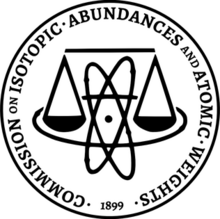Commission on Isotopic Abundances and Atomic Weights
 |
|
| Abbreviation | CIAAW |
|---|---|
| Formation | 1899 |
| Type | International scientific organization |
| Purpose | To provide internationally recommended values of isotopic composition and atomic weights of elements |
|
Region served
|
Worldwide |
|
Official language
|
English |
|
Chairman
|
Juris Meija |
|
Secretary
|
Thomas Prohaska |
|
Parent organization
|
IUPAC (since 1920) |
| Website | http://www.ciaaw.org |
The Commission on Isotopic Abundances and Atomic Weights (CIAAW) is an international scientific committee of the International Union of Pure and Applied Chemistry (IUPAC) under its Division of Inorganic Chemistry. Since 1899, it is entrusted with periodic critical evaluation of atomic weights of chemical elements and other cognate data, such as the isotopic composition of elements. The biennial CIAAW Standard Atomic Weights are accepted as the authoritative source in science and appear worldwide on the periodic table wall charts.
The use of CIAAW Standard Atomic Weights is also required legally, for example, in calculation of calorific value of natural gas (ISO 6976:1995), or in gravimetric preparation of primary reference standards in gas analysis (ISO 6142:2006). In addition, the current definition of kelvin, the SI unit for thermodynamic temperature, makes direct reference to the isotopic composition of oxygen and hydrogen as recommended by CIAAW. The latest CIAAW report was published in February 2016.
Although the atomic weight had taken on the concept of a constant of nature like the speed of light, the lack of agreement on accepted values created difficulties in trade. Quantities measured by chemical analysis were not being translated into weights in the same way by all parties and standardization became an urgent matter. With so many different values being reported, the American Chemical Society (ACS), in 1892, appointed a permanent committee to report on a standard table of atomic weights for acceptance by the Society. Clarke, who was then the chief chemist for the U.S. Geological Survey, was appointed a committee of one to provide the report. He presented the first report at the 1893 annual meeting and published it in January 1894.
In 1897, the German Society of Chemistry, following a proposal by Hermann Emil Fischer, appointed a three-person working committee to report on atomic weights. The committee consisted of Chairman Prof. Hans H. Landolt (Berlin University), Prof. Wilhelm Ostwald (University of Leipzig), and Prof. Karl Seubert (University of Hanover). This committee published its first report in 1898, in which the committee suggested the desirability of an international committee on atomic weights. On 30 March 1899 Landolt, Ostwald and Seubert issued an invitation to other national scientific organizations to appoint delegates to the International Committee on Atomic Weights. Fifty-eight members were appointed to the Great International Committee on Atomic Weights, including Frank W. Clarke. The large committee conducted its business by correspondence to Landolt which created difficulties and delays associated with correspondence among fifty-eight members. As a result, on 15 December 1899, the German committee asked the International members to select a small committee of three to four members. In 1902, Prof. Frank W. Clarke (USA), Prof. Karl Seubert (Germany), and Prof. Thomas Edward Thorpe (UK) were elected, and the International Committee on Atomic Weights published its inaugural report in 1903 under the chairmanship of Prof. Clarke.
...
Wikipedia
